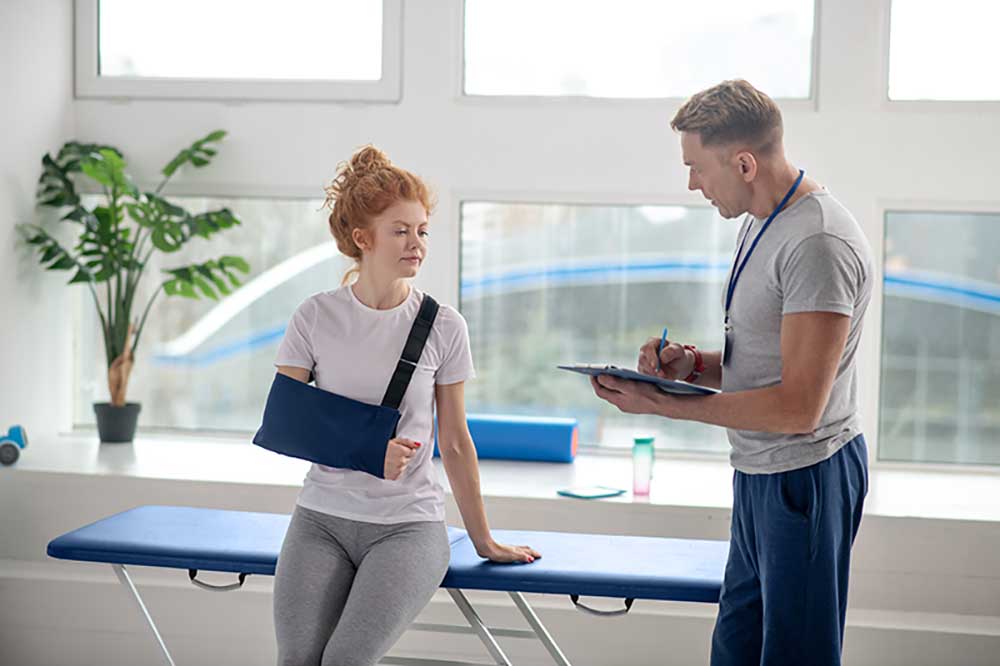Part one of this blog series focused on how to deal with swelling right after your surgery, before you start therapy. In today’s post we will discuss therapy after surgery; how therapy treatment sessions help with swelling management.
The Highway Theory
As a patient, you might wonder why your hand is puffy when your surgery was on your elbow or shoulder. A simple explanation is that everything is connected. Imagine your arm as an interstate highway; surgery on the elbow acts as a major collision that will block traffic to other areas. That traffic jam is like the fluid in your hands or fingers not able to cycle through your lymphatic system because of the crash. During your therapy treatment sessions, your therapist will divert the lymphatic fluid using other roads. The treatments we perform to decrease your swelling will assist in the following results:
- Help regain active range of motion
- Increase your strength
- Decrease scar adhesion
- Decrease pain
- Ultimately return you to previous levels of function
Impacts of Swelling
Swelling management over the course of therapy is crucial to your recovery because chronic swelling can have long-term negative affects. This occurs in 20-25% of patients following mechanical trauma of the soft tissue. Swelling can thicken your fascia, which leads to scar tissue build up. A fibrotic scar can be damaging to a moving joint and cause contracture. Contracture is a shortening and hardening of muscles, tendons or other tissue that often leads to deformity and rigidity of joints.
Swelling Management: How We Treat Swelling During Therapy After Surgery
We offer a diverse approach to treating edema depending on the severity, acuteness and type of swelling. We utilize all or a combination of the following techniques:
- Manual therapy or MERT -Manual Edema Resorption Techniques
- Compression dressing or wrapping
- Exercises
- Intermittent pneumatic compression
- Ultrasound
- Iontophoeresis
- Hi -Volt Galvanic Stimulation
- Cold laser
- Lymphatic kinesio taping
Let’s discuss some of these treatment techniques in more detail:
Manual Therapy or MERT
Manual therapy/MERT helps redirect the fluid back to the lymphatic system. It also helps with scar management by breaking down the fibrotic tissue. Kinesio taping can also assist with lymphatic flow.
Compression
Compression garments or dressings provide support to healing tissue. This directly impacts underlying venous and lymphatic vessels while also applying pressure to soften fibrous tissue and decrease the chance of developing a fibrotic scar. Compression garments can be compression gloves, gauntlets, or arm sleeves. Compression wrapping utilizes short stretch elastic bandages.
Exercises
Exercises improve venous and lymphatic return. The progressive increase in loading on the healing soft tissue will cause remodeling and realignment along lines of tensile force.
Therapeutic Ultrasound
Therapeutic ultrasound is a modality that has been used by therapists since the 1940s. Ultrasound is applied using the head of an ultrasound probe placed in direct contact with your skin via a transmission coupling gel. This modality may speed up tissue healing by increasing local blood flow and promoting scar breakdown.
HI Volt Galvanic Stimulation
HI Volt Galvanic Stimulation is a form of electrical stimulation to induce muscle contractions and is used to manage the formation of edema after acute injury. It has been suggested that this is achieved by:
- Limiting microvascular permeability, thus minimizing the leakage of plasma proteins from cell membranes into the interstitial fluid.
- Repelling large negatively charged plasma proteins from the interstitial space by the placement of the negatively charged electrodes over the skin, which in turn increases the uptake of plasma proteins into the lymphatic channels.
Iontophoresis
Iontophoresis (ionto) is a type of electrical stimulation that is used to administer specific medication into your body. A therapeutic modality commonly used in hand therapy to treat a variety of conditions, such as swelling and inflammation. The specific medication that is used in iontophoresis depends on the goals of treatment. Some medications are used to decrease inflammation, while others are used to decrease calcium deposits in muscle and tendon tissue. A common anti-inflammatory medication prescribed for ionto is dexamethasone. It is helpful in decreasing localized inflammation that occurs in musculoskeletal conditions such as tendinitis or bursitis. Inflammation causes pain, decreased tissue mobility, and swelling. Dexamethasone with the ionto therapy assists with decreasing your pain and improving mobility.
Cold Laser Treatment
Cold laser is an FDA-approved treatment that uses low levels of light to stimulate healing. This therapy can assist with tissue repair and relief from pain, inflammation and swelling. This treatment is non-invasive and is performed by moving the laser head over the affected area.
Let’s Wrap it Up!
At Alaska Hand Rehabilitation, we offer an arsenal of therapy techniques to help patients decrease the swelling, pain, and inflammation that may follow surgery. The treatment techniques used for swelling management will improve your upper extremity function to get you back to normal, faster. Your therapist will determine which treatment techniques are right for you after reviewing your referral from your surgeon and performing an initial evaluation. If you have further questions, please contact us!


